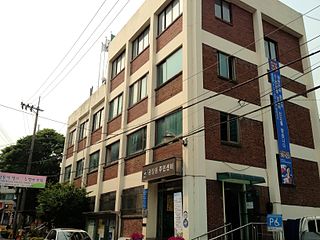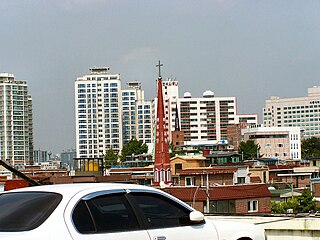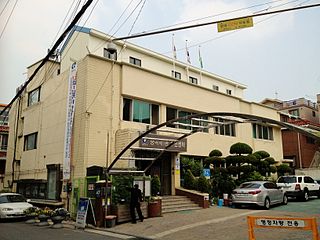Related Research Articles

Dongdaemun District is one of the 25 districts of Seoul, South Korea.

Gwangjin District is one of the 25 districts of Seoul, South Korea. It is located on the north bank of the Han River on the eastern end of Seoul. The district was split from the neighboring Seongdong District in 1995.

Susaek-dong is a dong, neighbourhood of Eunpyeong-gu in Seoul, South Korea.

Gwangjang-dong is a dong (neighborhood) of Gwangjin District, Seoul, South Korea.

Gunja-dong is a dong (neighborhood) of Gwangjin District, Seoul, South Korea. It is a transportation hub located on the southern side of Cheonho-daero, to the left of Jungnangcheon.

Guui-dong is a dong (neighborhood) of Gwangjin District, Seoul, South Korea.

Hwayang-dong (Korean: 화양동) is a dong (neighborhood) located in west Gwangjin District, Seoul, South Korea. It was incorporated into Gwangjin District on August 13, 1949. It is a mixed residential and small business area. Mojin-dong is also administered by Hwayang-dong and contains Konkuk University.
Jayang-dong is a dong, neighbourhood of Gwangjin-gu in Seoul, South Korea.

Junggok-dong is a dong, neighbourhood of Gwangjin-gu in Seoul, South Korea.
Noyu-dong is a dong, neighbourhood of Gwangjin-gu in Seoul, South Korea. It is a legal dong administered under its two administrative dong, Jayang 3-dong and Jayang 4-dong.
Mojin-dong is a dong, neighbourhood of Gwangjin-gu in Seoul, South Korea.
Jae-dong is a dong, neighbourhood of Jongno-gu in Seoul, South Korea. It is a legal dong administered under its administrative dong, Gahoe-dong.
Nuha-dong is a dong, neighbourhood of Jongno-gu in Seoul, South Korea. It is a legal dong administered under its administrative dong, Hyoja-dong.
Nusang-dong is a dong, neighbourhood of Jongno-gu in Seoul, South Korea. It is a legal dong administered under its administrative dong, Hyoja-dong.
Ogin-dong (Korean: 옥인동) is a dong (neighbourhood) of Jongno District, Seoul, South Korea. It is a legal dong, administered under its administrative dong, Hyoja-dong, of which it covers the westernmost part, until the fortress wall of Inwangsan.
Naesu-dong is a dong, neighbourhood of Jongno-gu in Seoul, South Korea. It is a legal dong administered under its administrative dong, Sajik-dong.
Jeokseon-dong is a dong, neighbourhood of Jongno-gu in Seoul, South Korea. It is a legal dong administered under its administrative dong, Sajik-dong.
Pirun-dong is a dong, neighbourhood of Jongno-gu in Seoul, South Korea. It is a legal dong administered under its administrative dong, Sajik-dong.
Pyeong-dong is a dong, neighbourhood of Jongno-gu in Seoul, South Korea. It is a legal dong administered under its administrative dong, Gyonam-dong.
Oksu-dong is a dong, (neighbourhood), of Seongdong-gu in Seoul, South Korea.
References
- 1 2 "능동 (Neung-dong 陵洞)" (in Korean). Doosan Encyclopedia . Retrieved 2008-04-22.[ permanent dead link ]
- ↑ "The origin of Neung-dong" (in Korean). Gwangjin-gu official site. Retrieved 2008-04-22.[ permanent dead link ]
- "Chronicle of Beopjeong-dong and Haengjeong-dong" (in Korean). Guro-gu Official website.
